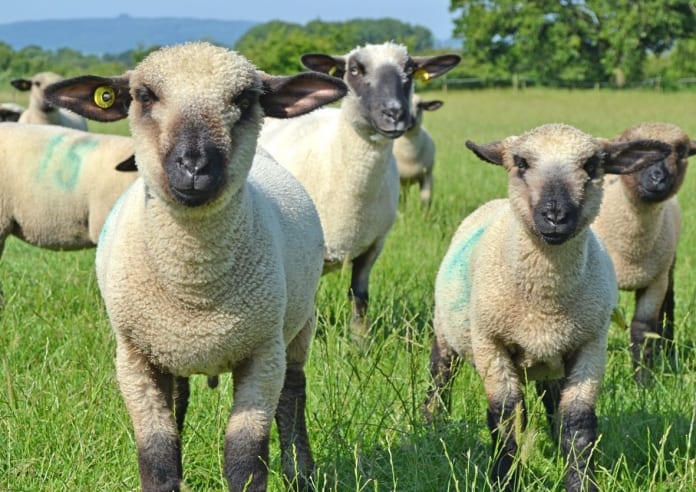Ewe lambs and yearlings can eat more than three per cent of their liveweight a day grazing fodder beet but the crop must have good leaf cover and be correctly allocated to achieve this intake for good liveweight growth.
At a typical UK yield of 20tDM/hectare (ha), fodder beet can be grazed at high stocking rates – 100 multiple-bearing ewes/ha or 125 ewe lambs or yearlings/ha.
The leaf is rich in protein while the bulb is energy dense. But, in sheep systems, it is not an option to rely on a supplementary silage or grass to balance a crop that has poor leaf cover, which can be caused by foliar disease in the autumn, fodder beet expert Dr Jim Gibbs advises.
“It is very difficult to supply the protein in supplementary feed without the fibre content getting in the way and impeding intakes,” he warned farmers listening to a recent webinar hosted by Farming Connect in conjunction with Field Options, KWS and Momont.
For fodder beet to be fed successfully to ewe lambs and hoggets it must be agronomically well-managed, Dr Gibbs stressed.
“If it is, you can easily achieve over three per cent of liveweight intake a day,” he said.
Over-allocation will result in sheep eating more of the protein-rich leaf than the energy-dense bulb, resulting in sub-optimal energy intakes and potential health issues such as ketosis and twin lamb disease.
Under-allocation must also be avoided.
“It can be tempting to under-allocate to force the sheep to clear up the bulbs but, in this situation, you can wildly under-allocate and with no solid protein to eat with the bulb, intakes will crash,” said Dr Gibbs.
Strip graze and allocate 1m of the face length per 3-4 ewes – most UK crop allocation is slightly higher than 1m² per ewe.
It can be grazed in multiple day breaks but it is rare to push this beyond two or three days. “Two-day breaks are ideal,” said Dr Gibbs.
For younger sheep, it is almost always a requirement to provide a supplementary feed every other day – ideally co-grazing fodder beet with pasture or, if this is not possible, by offering good quality silage.
For this class of sheep, provide 100g of dry matter (DM) – this is often done every other day.
Including 100g DM of supplementary feed to ewes either daily or every other day can marginally increase beet intakes.
Palatable fodder beet varieties are very important in sheep systems. If it is unpalatable, they will eat very little of the bulb and that will increase the total crude protein in their diet.
Unlike cattle, sheep don’t need a transition period.
“They regulate their intakes differently so the process is to run the flock on and off the crop for a few hours, for a few days, then lock them on,” says Dr Gibbs.
All classes of sheep must be fully vaccinated for clostridial diseases before they are turned onto the crop.
“Losses can be significant if sheep are not properly vaccinated,” Dr Gibbs warned.
It is also advantageous to give a parasite control.
Trace element supplementation, copper and selenium in particular, will depend on naturally occurring levels for individual regions – seek local veterinary advice on this, Dr Gibbs recommends.
It is very rare for sheep to succumb to acidosis on fodder beet. “In a career in fodder beet I have only seen a handful of cases,” said Dr Gibbs.
Fodder beet is not suitable for grazing in lamb finishing systems because, unlike cattle, its crude protein level is too low to achieve the required liveweight gains.
However, it can be used as a ‘holding tank’, Dr Gibbs suggested.
“It is possible to achieve 100g/day of liveweight gain grazing at very high stocking rates and to pull the lambs off the fodder beet in groups to finish on a suitable high crude protein diet,” he said.
However, an effective alternative for lamb finishing is to lift the beet, scattering it onto pasture and strip grazing the grass and beet.
“The beet then makes up about 50% of the diet,” says Dr Gibbs. “This will allow the stocking rate to be doubled because energy intakes are dramatically increased.”
If you missed this event, the recording will shortly be available on the Farming Connect website for a short period of time.
Farming Connect, which is delivered by Menter a Busnes and Lantra, has received funding through the Welsh Government Rural Communities – Rural Development Programme 2014-2020, which is funded by the European Agricultural Fund for Rural Development and the Welsh Government.
Help keep news FREE for our readers
Supporting your local community newspaper/online news outlet is crucial now more than ever. If you believe in independent journalism, then consider making a valuable contribution by making a one-time or monthly donation. We operate in rural areas where providing unbiased news can be challenging. Read More About Supporting The West Wales Chronicle























